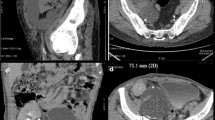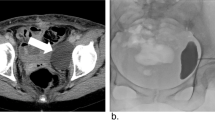Abstract
Objective
To report the efficacy and safety of povidone-iodine sclerotherapy of primary symptomatic lymphocele after kidney transplantation in a large contemporary cohort study.
Patients and methods
A single-institutional study was conducted including consecutive patients who underwent povidone-iodine sclerotherapy for primary symptomatic lymphocele after kidney transplantation between January 2013 and March 2020. Sclerotherapy was used as the first-line treatment of symptomatic lymphocele. Recurrent lymphoceles were managed with open or laparoscopic fenestration. The primary outcome was the efficacy of sclerotherapy which was defined as the absence of second sclerotherapy or salvage surgery.
Results
A total of 965 renal transplantations were included. Sclerotherapy for primary symptomatic lymphocele was performed in 60 cases (6.2%). The median (IQR) number of instillation, the volume of povidone-iodine per instillation and drainage time were 3 (3–3), 60 (38–80) mL and 6 days (5–8), respectively. Sclerotherapy related complications were reported in eight cases (13.3%) and included five cases of accidental catheter removal, two cases of lumbosciatica, and one case of intraperitoneal diffusion of povidone-iodine. After a median (IQR) follow-up of 33 (14–60) months, treatment success was achieved in 33 cases (55%). Multivariate analysis failed to identify predictors of sclerotherapy failure. Salvage therapies included 7 s sclerotherapy and 20 surgical fenestrations with an overall success rate of 88.8% (24/27).
Conclusions
Sclerotherapy was an easy and safe procedure to treat primary symptomatic lymphocele in renal transplant recipients. Despite moderate efficacy, recurrences were easily controlled with salvage therapies. Further studies are necessary to identify predictive factors of sclerotherapy failure to directly refer patients to surgical treatment.
Similar content being viewed by others
References
Naveen KA, Frank M, Fahim Z et al (2004) Post transplant lymphocele: a single centre experience. Clin Transpl 18(12):46–49
Allen RDM (2008) Vascular complications after kidney transplantation. In: Morris PJ, Knechtle SJ (eds) Kidney transplantation (edn 6). W. B. Saunders, Philadelphia, pp 450–453
Ulrich F, Niedzwiecki S, Fikatas P et al (2010) Symptomatic lymphoceles after kidney transplantation - multivariate analysis of risk factors and outcome after laparoscopic fenestration. Clin Transpl 24(2):273–280
Ania L, Germaine W, Vincent WTL et al (2011) Management of primary symptomatic lymphocele after kidney transplantation: a systematic review. Transplantation 92(6):663–673
Rodríguez Faba O, Boissier R, Budde K et al (2018) European Association of Urology Guidelines on Renal Transplantation: Update 2018. Eur Urol Focus 4(2):208–215
Teruel JL, Escobar EM, Quereda C, Mayayo T, Ortuño J (1983) A simple and safe method for management of lymphocele after renal transplantation. J Urol 130(6):1058–1059
Teruel JL, Matesanz R, Orte L et al (1987) About the treatment of lymphocele. Nephron 45(1):73
Gilliland JD, Spies JB, Brown SB et al (1989) Lymphoceles: percutaneous treatment with povidone-iodine sclerosis. Radiology 171(1):227–229
Rivera M, Marcen R, Burgos J et al (1996) Treatment of posttransplant lymphocele with povidone-iodine sclerosis: long-term follow-up. Nephron 74(2):324–327
Montalvo BM, Yrizarry JM, Casillas VJ et al (1996) Percutaneous sclerotherapy of lymphoceles related to renal transplantation. J Vasc Interv Radiol 7(1):117–123
Burgos FJ, Teruel JL, Mayayo T et al (1988) Diagnosis and management of lymphoceles after renal transplantation. Br J Urol 61(4):289–293
Doehn C, Fornara P, Fricke L et al (2002) Laparoscopic fenestration of posttransplant lymphoceles. Surg Endosc 16(4):690–695
Chin A, Ragavendra N, Hilborne L et al (2003) Fibrin sealant sclerotherapy for treatment of lymphoceles following renal transplantation. J Urol 170(2 Pt 1):380–383
Huilgol AK, Sundar S, Karunagaran SG et al (2003) Lymphoceles and their management in renal transplantation. Transpl Proc 35(1):323
Tasar M, Gulec B, Saglam M et al (2005) Posttransplant symptomatic lymphocele treatment with percutaneous drainage and ethanol sclerosis: long-term follow-up. Clin Imaging 29(2):109–116
Silas AM, Forauer AR, Perrich KD et al (2006) Sclerosis of postoperative lymphoceles: avoidance of prolonged catheter drainage with use of a fibrin sealant. J Vasc Interv Radiol 17(11 Pt 1):1791–1795
Abou-Elela A, Reyad I, Torky M et al (2006) Laparoscopic marsupialization of postrenal transplantation lymphoceles. J Endourol 20(11):904–909
Capocasale E, Busi N, Valle RD et al (2006) Octreotide in the treatment of lymphorrhea after renal transplantation: a preliminary experience. Transpl Proc 38(4):1047–1048
Zomorrodi A, Buhluli A (2007) Instillation of povidone-iodine to treat lymphocele and leak of lymph after renal transplantation. Saudi J Kidney Dis Transpl 18(4):621–624
Zargar-Shoshtari MA, Soleimani M, Salimi H et al (2008) Symptomatic lymphocele after kidney transplantation: a single-center experience. Urol J Winter 5(1):34–36
Damiano G, Lombardo C, Palumbo VD et al (2011) A simple method to treat post-kydney transplantation lymphocele. G Chir 32(1–2):73–76
Maja J, d’Ancona FC, van der Meijden WA, Poyck PP (2019) Predictors of symptomatic lymphocele after kidney transplantation. Int Urol Nephrol 51(12):2161–2167
Author information
Authors and Affiliations
Corresponding author
Additional information
Publisher's Note
Springer Nature remains neutral with regard to jurisdictional claims in published maps and institutional affiliations.
Rights and permissions
About this article
Cite this article
Baboudjian, M., Tadrist, A., Gondran-Tellier, B. et al. Povidone-iodine sclerotherapy of primary symptomatic lymphocele after kidney transplantation. Int Urol Nephrol 53, 685–690 (2021). https://doi.org/10.1007/s11255-020-02709-2
Received:
Accepted:
Published:
Issue Date:
DOI: https://doi.org/10.1007/s11255-020-02709-2




